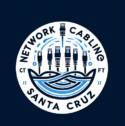Which Is Required to Connect a Network Cable to a Computer?
If you’ve ever wondered what exactly you need to connect a network cable to your computer, you’re not alone. Whether you’re setting up a home office, gaming setup, or business workstation, understanding how network cabling works is the first step to creating a fast and reliable internet connection.
Let’s break it down in simple terms so you’ll know exactly what’s required and how to do it right. Our Santa Cruz network wiring specialists make sure every connection between computers and network systems is installed correctly for peak performance.
What You Need to Connect a Network Cable to a Computer
To connect a network cable (often called an Ethernet cable) to your computer, you need one simple but important piece of hardware — a network interface card (NIC) or Ethernet port.
Here’s what’s required:
- An Ethernet Port or Network Adapter – Most desktop computers and laptops already have one built in. If your laptop doesn’t, you can use a USB-to-Ethernet adapter.
- An Ethernet Cable (CAT5e, CAT6, or CAT6a) – This is the physical cable that connects your device to a router, modem, or network switch.
- A Router, Switch, or Modem – This device distributes internet access to your connected computers.
- A Stable Internet Source – Either a wired internet service provider (ISP) line or a local area network (LAN).
When all of these components are in place, your computer can establish a direct, wired connection to the network — providing faster speeds and lower latency than Wi-Fi.
Step-by-Step: How to Connect Your Computer to a Network Cable
Follow these simple steps to get connected:
- Locate the Ethernet Port
Look for a rectangular port on the side (for laptops) or back (for desktops) of your computer labeled with a small three-box network icon. - Plug in the Ethernet Cable
Take your CAT5e or CAT6 cable and insert it into the port until it clicks securely in place. - Connect the Other End to Your Router or Switch
Plug the other end of the cable into a LAN port on your router or network switch. - Check for Connection
Your computer should automatically detect the wired connection. If not, go to Network Settings and make sure Ethernet is enabled. - Test Internet Access
Open a browser or run a speed test to confirm you’re connected.
Why Use a Wired Connection Instead of Wi-Fi?
While wireless networks are convenient, a wired connection using an Ethernet cable has clear advantages:
- Faster Speeds – Ideal for gaming, streaming, and transferring large files.
- Lower Latency – Reduces lag and buffering during video calls or online gaming.
- Better Stability – Unaffected by Wi-Fi interference or distance from the router.
- Higher Security – Harder for unauthorized users to intercept compared to wireless signals.
If you’re serious about performance, wired connections are the best choice for consistency and reliability.
Types of Network Cables You Can Use
Not all Ethernet cables are the same. Here are the most common options:
- CAT5e – Supports speeds up to 1 Gbps (suitable for most home networks).
- CAT6 – Handles speeds up to 10 Gbps over shorter distances; great for offices or gaming.
- CAT6a – Enhanced version of CAT6, supports 10 Gbps over longer distances.
- CAT7 / CAT8 – Designed for data centers and ultra-high-speed environments.
When installing a new system, CAT6 or CAT6a is recommended for future-proofing and better performance. Before connecting a cable to your computer, it’s essential to know the important parts needed to install a network.
Common Problems and How to Fix Them
If your computer isn’t connecting to the network, here are a few quick troubleshooting steps:
- Check the cable – Ensure it’s not damaged or loosely plugged in.
- Restart your router – Simple but effective fix for many network issues.
- Update your network drivers – Outdated software can prevent connectivity.
- Try a different port or cable – Helps determine if the issue is with the hardware.
- Verify IP settings – Ensure your device is set to obtain an IP address automatically.
If you still can’t connect, the problem may be with your network adapter or router configuration, and you might need professional assistance.
When to Call a Professional
If you’re setting up multiple computers, a business network, or need long cable runs through walls or ceilings, it’s best to contact a licensed network cabling installer. Professionals can ensure your cabling meets performance standards, avoids interference, and complies with local electrical codes.
A skilled technician can also help you design a structured cabling system, making your network easier to manage and expand in the future.
Final Thoughts
Connecting a network cable to a computer is simple once you understand the basics — you just need the right Ethernet port, cable, and network connection. But if you’re planning a more complex or permanent setup, investing in professional structured cabling installation will give you a faster, cleaner, and more reliable network. Not all cables deliver the same performance — find out how to determine the best cable to use in a network.
So next time you’re setting up a workstation or upgrading your network, make sure you’re wired for performance — literally.
